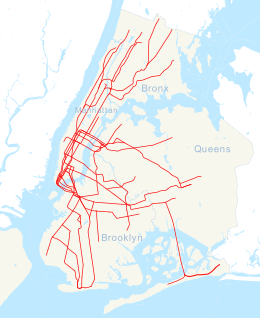Myrtle–Willoughby Avenues station
Myrtle–Willoughby Avenues is a station on the IND Crosstown Line of the New York City Subway. Located at the intersection of Myrtle and Marcy Avenues in Bedford-Stuyvesant, Brooklyn, it is served by the G train at all times.
Myrtle–Willoughby Avenues | |||||||
|---|---|---|---|---|---|---|---|
 Northbound platform | |||||||
| Station statistics | |||||||
| Address | Myrtle Avenue & Marcy Avenue Brooklyn, NY 11206 | ||||||
| Borough | Brooklyn | ||||||
| Locale | Bedford-Stuyvesant | ||||||
| Coordinates | 40.694631°N 73.949103°W | ||||||
| Division | B (IND) | ||||||
| Line | IND Crosstown Line | ||||||
| Services | G | ||||||
| Transit connections | |||||||
| Structure | Underground | ||||||
| Platforms | 2 side platforms | ||||||
| Tracks | 2 | ||||||
| Other information | |||||||
| Opened | July 1, 1937[1] | ||||||
| Station code | 288[2] | ||||||
| Wireless service | |||||||
| Opposite-direction transfer available | Yes | ||||||
| Traffic | |||||||
| Passengers (2019) | 1,820,637[4] | ||||||
| Rank | 255 out of 424[4] | ||||||
| Station succession | |||||||
| Next north | Flushing Avenue: G | ||||||
| Next south | Bedford–Nostrand Avenues: G | ||||||
| |||||||
| |||||||
| |||||||
History
This station opened on July 1, 1937, when the entire Crosstown Line was completed between Nassau Avenue and its connection to the IND Culver Line. On this date, the GG was extended in both directions to Smith–Ninth Streets and Forest Hills–71st Avenue.[1]
Station layout
| G | Street level | Entrances/exits |
| B1 | Mezzanine | Station agent, fare control, MetroCard machines |
| B2 Platform level |
Side platform | |
| Northbound | ← | |
| Southbound | | |
| Side platform | ||
| Underpass | Connection between platforms | |
This underground station has two tracks and two side platforms.[5] Both platforms have a light green trim line on a darker green border that is cut up into numerous sections due to the large name tablets, which have "MYRTLE - WILLOUGHBY AVE." on two lines in white sans serif font on a dark green background and a lighter green border. There are small directional signs pointing to fare control below the name tablets and station name signs below the trim line that alternate between "MYRTLE" and "WILLOUGHBY," both of which have white lettering on a black tile background. Vent chambers are located on the tile wall. Both platforms have blue I-beam columns at regular intervals with every other one having the standard black station name plate in white lettering.
Exits

The platforms each have one same-level fare control area at their north ends.[5] The one on the Church Avenue-bound side has a bank of three turnstiles, token booth, and staircase going up to the northwest corner of Marcy and Myrtle Avenues. The one on the Queens-bound side is unstaffed, containing two High Entry/Exit turnstiles and one exit-only turnstile and a short double-wide staircase that goes up to a short landing before a standard perpendicular staircase goes up to the northeast corner of Myrtle and Marcy Avenues.[5][6] Two staircases on both platforms adjacent to fare control go down to a crossunder to allow a free transfer between directions.
Both platforms formerly had another same-level entrance/exit at their south ends and directional signs indicate they led to Willoughby Avenue.[5] The spaces are blocked with chain link fences and some of the single street staircases on each side remain intact.
References
- "New Crosstown Subway Line Is Opened". Brooklyn Daily Eagle. July 1, 1937. Retrieved December 24, 2015.
- "Station Developers' Information". Metropolitan Transportation Authority. Retrieved June 13, 2017.
- "NYC Subway Wireless – Active Stations". Transit Wireless Wifi. Retrieved November 13, 2019.
- "Facts and Figures: Annual Subway Ridership 2014–2019". Metropolitan Transportation Authority. 2020. Retrieved May 26, 2020.
- "Review of the G Line: Appendices" (PDF). Metropolitan Transportation Authority. July 10, 2013. Retrieved October 28, 2015.
- "MTA Neighborhood Maps: Bedford-Stuyvesant" (PDF). Metropolitan Transportation Authority. 2016. Retrieved July 5, 2016.
External links
| Wikimedia Commons has media related to Myrtle–Willoughby Avenues (IND Crosstown Line). |
- nycsubway.org – IND Crosstown Line: Myrtle–Willoughby Avenues
- Station Reporter — G Train
- The Subway Nut — Myrtle–Willoughby Avenues Pictures
- Myrtle Avenue entrance from Google Maps Street View
- Platforms from Google Maps Street View



